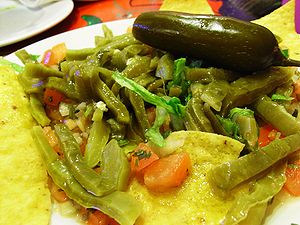 Submitted by Kindred Soul on
Submitted by Kindred Soul on

Nopal Cactus has been used for thousands of years by Mexican natives and Native Americans, both as a food and for enhanced health and vitality. Nopal (from the Nahuatil word nohpalli for the pads) is a vegetable made from the young cladole (pad) segments of prickly pear prickly, carefully peeled to remove the spines. These fleshy pads are flat and about hand-sized. They can be purple or green. They are particularly common in their native Mexico, where the plant is eaten commonly and regularly forms part of a variety of Mexican cuisine dishes. Farmed nopales are most often of the species Opuntia ficus indica, although the pads of almost all Opuntia species are edible. The neon red prickly pear, the fruit of the nopal cactus, tastes like a cross between bubblegum and watermelon.
The other names for Nopal Cactus are: Barbary-fig Cactus, Cactus Flowers, Cactus Fruit, Cactus Pear Fruit, Figue d’Inde, Figuier de Barbarie, Fruit du Cactus, Fruit de l’Oponce, Gracemere-Pear, Indian-fig Prickly Pear Cactus, Indien-Figue, Nopal, Nopal Cactus, Nopales, Nopol, OPI, Oponce, Opuntia, Opuntia cardona, Opuntia ficus, Opuntia ficus-indica, Opuntia Fruit, Opuntia fuliginosa, Opuntia hyptiacantha, Opuntia lasciacantha, Opuntia macrocentra, Opuntia megacantha, Opuntia puberula, Opuntia streptacantha, Opuntia velutina, Opuntia violacea, Prickly Pear, Tuna Cardona, Westwood-Pear.

Nopal Growth

Nopal Salad
Nopal Cactus is hearty and can adapt to almost any environment. They are native to the Western Hemisphere but can be successfully introduced in other areas of the globe.
The first introduction of prickly-pear into Australia can be definitely ascribed to Governor Philip and the earliest colonists in the year 1788. Brought from Brazil to Sydney, they remained in Sydney, New South Wales, where it was rediscovered in a farmer's garden in 1839. The farmer's wife gave cuttings to neighbors and friends, who planted it not only in their gardens but also as hedgerows. So began the Australian invasion that caused major ecological damage in the Eastern states. They are also found in the Mediterranean region of Northern Africa, especially in the most northern nation of Africa, Tunisia, where they grow all over the countryside, and southern Europe, especially on the island nation of Malta, where they grow all over the islands, in the south-east of Spain, and can be found in enormous numbers in parts of South Africa, where it was introduced from South America. In parts of the Middle East, prickly pears of the yellow and orange varieties are grown by the side of farms, beside railway tracks and other otherwise noncultivable land. It is sold in summer by street vendors, and is considered a nice refreshing fruit for that season.
Benefits:
- Medical research in the past decade confirmed that nopales has the ability to lower LDL cholesterol levels.
- It may contain the richest source of betalains in the plant kingdom. Betalains are glycosides, which means they help to reduce blood glucose levels
- Protection of blood vessels and the lymph system. (Betalatins protect against free radical effects of redox alteration from cytokines, the "signal" proteins that regulate the immune system.)
- Prickly pear cactus is used for type 2 diabetes, high cholesterol, obesity, alcohol hangover, colitis, diarrhea and benign prostatic hypertrophy (BPH). It is also used to fight viral infections.
- The gel-like sap of prickly pears might be useful as a hair conditioner.
- 3330 reads